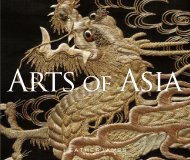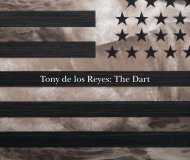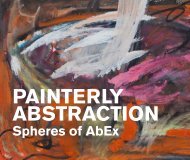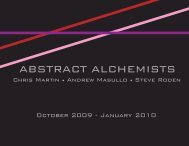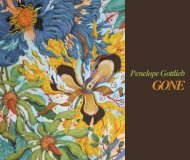EARL CUNNINGHAM: American Fauve - Heather James Fine Art
EARL CUNNINGHAM: American Fauve - Heather James Fine Art
EARL CUNNINGHAM: American Fauve - Heather James Fine Art
You also want an ePaper? Increase the reach of your titles
YUMPU automatically turns print PDFs into web optimized ePapers that Google loves.
world by maintaining it as special and semiprivate preserve.<br />
Although the noted <strong>American</strong> surrealist photographer Jerry Uelsmann, who<br />
documented in 1970 Cunningham’s antique shop, studio, and gallery for the artist’s first museum<br />
exhibition at the Loch Haven <strong>Art</strong> Center in Orlando (now the Orlando Museum of <strong>Art</strong>) could<br />
not “imagine Cunningham reading art books,” 3 the artist did come in contact with modern art<br />
through a number of sources, including printed matter, and embraced a number of its tenets in<br />
his painting. Even though he may have picked up ideas from the comments and questions of<br />
customers visiting his antique shop, Cunningham most likely became acquainted with modern<br />
art from the surprising number of articles on the subject published in Life magazine, beginning<br />
in the late 1930s. Uelsmann remembers seeing sacks of Life, Collier’s, and National Geographic<br />
magazines in Cunningham’s antique shop, “so many in fact that it was dangerous.” 4<br />
In addition to Life, Cunningham had the opportunity to know some modern works<br />
of art through large second-hand framed reproductions he sold in his shop. In one Uelsmann<br />
photograph of Cunningham’s shop, there is a reproduction of a late Maurice de Vlaminck being<br />
offered for sale. Considering the presence of this image in the shop, it is possible Cunningham<br />
sold, over the years, reproductions of many popular works by Vincent van Gogh, Matisse, and the<br />
Impressionists that were widely circulated at the time. Repeated access to these reproductions<br />
would have exposed him to some basic modern art concepts such as a high-keyed color palette,<br />
and this familiarity helps to explain the penchant for saturated hues in his own paintings.<br />
Cunningham could have also come in contact with basic attitudes about modern art<br />
found in such Walt Disney animated films as Snow White and the Seven Dwarfs (1937) and<br />
Fantasia (1940). Since he made paintings of Disney’s seven dwarfs at some point between<br />
the late ‘30s and early ‘50s, he was no doubt acquainted with the film, the intensity and range<br />
of its colors and its sense of fantasy. 5 Because Cunningham did not accept commissions,<br />
the decision to re-create images of Disney’s dwarfs, without doubt, was done under his own<br />
initiative. Cunningham’s knowledge of this film is crucial to an understanding of his overall<br />
work because it indicates a familiarity with expressionistic ideas, particularly evident in the<br />
forest scene early in the film when the huntsman takes Snow White outside the palace and<br />
deserts her. In this segment, the forest assumes some characteristics of Charles Burchfield’s<br />
early whimsical paintings, particularly the device of repeating outlines around trees and plants to<br />
suggest spiritual emanations and sometimes to reveal incipient anthropomorphic features. Even<br />
though the latter do not occur in Cunningham’s work, his staggered sets of outlines are readily<br />
apparent in some early paintings and are relevant to his overall style. This stylistic device<br />
found in Burchfield’s work and some of Disney’s films is indicative of Cunningham’s indirect<br />
connections with both synaesthesia and the art of Russian Expressionist Wassily Kandinsky,<br />
who wished to establish equivalences between color, shape, and sound, and in Cunningham’s<br />
work it points to the artist’s attempt to move beyond surface appearances in order to reveal<br />
a more profound cross-section of the world he was conjuring in his paintings. In fact, Snow<br />
White and Fantasia could have served Cunningham as short courses in modern art’s seemingly<br />
arbitrary intense colors, which were originated in the work of Van Gogh, Paul Gauguin, and<br />
the <strong>Fauve</strong>s.<br />
In consideration of the sophistication of Cunningham’s work, it is not farfetched to<br />
align it with the highly subtle and remarkable ideas of the French Symbolist movement, which<br />
provided Gauguin and Matisse, among others, with a rationale for employing saturated hues.<br />
But if one recognizes how profoundly these Symbolist concepts permeated popular culture,<br />
including animated cartoons, mass media advertising, and fashion, their indirect impact on<br />
Cunningham seems far more plausible. The reason for pointing out their relevance to his art is<br />
not simply to elevate his paintings by association, even though that might be a residual effect,<br />
but to point out how Cunningham has claimed for vernacular art some of the same avant-garde<br />
concepts disseminated throughout the culture. In his work, then, Cunningham invokes some<br />
of the original Symbolist concepts, such as the absolute reality of the abstract components of<br />
painting, such as shape and color. Although he never relinquished the realm of appearances in<br />
his art, he does revel in the abstract power of color as his saffron oceans and skies, raspberry bays,<br />
and chocolate waterways so eloquently testify.<br />
Cunningham’s relation to color bespeaks the strong convictions he had about the<br />
world and the ideal realm he was depicting in his art. The saturated hues in his art imply a<br />
deep involvement with his subject to the point that he does not take time to modulate colors<br />
but instead prefers to use them in large doses to convey strong feelings. The fresh and intense<br />
color in his art supports his Edenic subject matter by signifying a world created anew, unspoiled<br />
and full of intense light. His color also has the distinct psychological advantage of suggesting<br />
contradictory ways of approaching his dreamscapes. It may be seen as paralleling psychologist<br />
C.G. Jung’s advice to a patient constructing a mandala “not to be afraid of bright colors, . . .<br />
[because] vivid colors seem to attract the unconscious.” 6 The question of whether color makes<br />
the dream more real or whether it heightens its unreality and thus guarantees its status as a<br />
14





